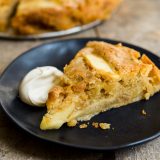There is a reason the American apple pie, rather than apple cake, resides in the culinary hall of fame. Apple pie is the essence of the apple itself: some are juicy and some are not. An apple pie cares less about moisture content since the top crust remains crisp and above the fray.
An apple cake, however, turns to mush with super-juicy apples, or the fruit simply drops to the bottom, forming a wet substrata. Tricky business.
Yet the French apple cake offers an offhand charm. It is a last-minute dessert thrown together without a recipe. When one requests exact measurements, French cooks explain the process with a disdainful flick of the head, an exhalation of cigarette smoke and a phrase of discouragement: “N’importe.”
There is no cutting butter into “pea-size pieces.” No rolling out dough. And no pie crust.
We started with an apple cake recipe that called for whole-egg foam as the foundation, then used a high proportion of batter to fruit. One bunch of apples worked great; the next batch ended up, well, a soggy mess. Though the cake was well-liked by some, we couldn’t abide the divide: apples on the bottom and cake on top.
We moved on to a French apple cake recipe from Dorie Greenspan made with a simple flour-egg-rum-melted butter affair and four large apples peeled and cut into ½-inch chunks. This was a better batter—and less of it, which produced a dessert that was more custardy than cakelike.
It also was more dependable. Particularly juicy apples didn’t sink to the bottom of the pan like wet leaves in a pond. But we still wanted less moisture and more flavor.
To solve the first problem, we sliced the apples thinly and precooked them. This reduced the water content, making the recipe more concentrated in flavor and more reliable. For even more flavor, we browned the butter.
We initially microwaved the apple slices, but the skillet used for browning the butter was now primed to cook the apple slices with 2 tablespoons sugar, a common approach when making, say, a tarte tatin. Less water and a bit of caramelization boosted flavor and solved the soggy texture problem, as well.
We also reduced the batter amount slightly and upped the number of apples, which meant less cake and more filling. We had arrived at our ideal version—a cross between apple pie, tarte tatin and apple cake.
There is nothing offhand about this recipe. It is not a “little of this, a little of that,” but it still qualifies as everyday—not food “for company.”
And with a few minutes more work—browning butter and briefly cooking the apples—we had a dessert enough for the hall of fame, right next to the blue ribbon winner, American apple pie.




